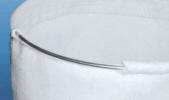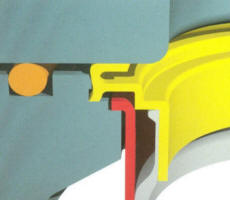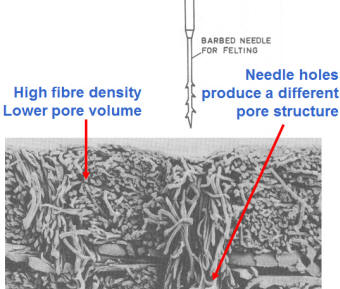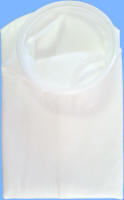Modern technology has resulted in a proliferation of filter bag designs,
but unfortunately they all tend to look similar and pricing is often a major
factor in the decision process – but that might be shortsighted and increasing
operational costs.
Filter bags are installed within filter housings, a pressure vessel that
directs the process flow through the filter media to remove unwanted particles.
Filter bags are designed to be thrown away after use, attempting to clean and
reuse them is not recommended. The “cost” of a filter bag begins with the media
itself but also involves the frequency of filter bag changes and the annual
disposal costs. It is the frequency of changing and perhaps reduced
quantity of filter bags required annually that often contributes most to
reduction in operational costs.
Filter Bag Designs
 The physical structure of filter bags fall into three categories, mesh,
needle-felt and melt-blown. The manufacturing technique for each category
determines the materials of construction that can be used.
The physical structure of filter bags fall into three categories, mesh,
needle-felt and melt-blown. The manufacturing technique for each category
determines the materials of construction that can be used.
Needle-felt filter bags are generally the least expensive style and are
the most common with mesh styles being a little more expensive mostly due to the
materials compatible with the required manufacturing process. Melt-blown
and multi-layered filter bags are the most expensive but also provide higher
efficiencies.
Filter Bag Sealing Rings
 In addition to the material and manufacturing process, filter bags have a
sealing ring designed to prevent particulates from bypassing the material.
The sealing ring thus provides a seal between the filter bag and the vessel.
The most common sealing ring designs are a “snap-ring” and a “crush-seal ring”.
In addition to the material and manufacturing process, filter bags have a
sealing ring designed to prevent particulates from bypassing the material.
The sealing ring thus provides a seal between the filter bag and the vessel.
The most common sealing ring designs are a “snap-ring” and a “crush-seal ring”.
A snap-ring is a metal or plastic ring sewn within the opening of the
filter bag, which aligns with a groove within the filter bag housing.
Based upon the tolerance of the groove and ring, the filter bag is held firmly
in-place yet can be removed by hand for change-outs; filter bags have handles to
grab so they can be lifted from the vessel.
 A crush-seal ring is a geometrical shaped plastic ring that also has an
outer diameter that “snaps” into the support basket groove. Sealing is
further enhanced by downwards pressure onto the top of the sealing ring, which
creates an outward force and improving the seal between the ring and sealing
grove. The downwards pressure is achieved by the filter vessel cover,
either directly or via a hold-down ring to transmit the downwards force of a
closed chamber cover to the top of the filter bag.
A crush-seal ring is a geometrical shaped plastic ring that also has an
outer diameter that “snaps” into the support basket groove. Sealing is
further enhanced by downwards pressure onto the top of the sealing ring, which
creates an outward force and improving the seal between the ring and sealing
grove. The downwards pressure is achieved by the filter vessel cover,
either directly or via a hold-down ring to transmit the downwards force of a
closed chamber cover to the top of the filter bag.
Filter Bag Efficiency
Filter bag retention is referred to as being nominal or absolute.
Nominal in this context essentially means “approximately” whereas absolute is
related to a specified efficiency. Higher efficiency filter bags are more
complex and expensive therefore generally reserved for the most demanding
applications.
There is no industry standard relating “nominal” to a specific efficiency;
each manufacturer determines the acceptable range of efficiency and thus it
is necessary to compare filter bag performance and NOT rely on the stated
nominal retention.
The efficiency for our nominally rated filter bags tends to be 65-70% and
I am told that some manufacturers reduce costs by accepting lower efficiencies,
so “you get what you pay for” applies to filter bags as most other things in
life.
SNAP-RING®
Although also an accurate description of the seal type and generically
referred to as “snap-ring” it is also a registered trademark owned by Eaton
Hydraulics, Filtration Division LLC. These represent their inexpensive
line of filter bags, offered in polyester, polypropylene, nylon, nomex and PTFE
felt materials. The rings sewn into the filter bag openings are zinc
plated steel, 316SS or polypropylene.
SNAP-RING® filter bags have a sewn construction. A web of
material is perforated with a needle board to create the holes determining
retention and one side is singed to reduce the change of fibers “migrating”
downstream.

Materials are mass produced by mills and tested for their retention
efficiencies, then sold to companies which manufacture filter bags.
SNAP-RING® filter bags have a nominally rated efficiency. Although
offered in 1, 5, 10 and 25 micron sizes, the limitations of a snap-ring seal
with the sewn construction makes them best for 50+ micron retention
applications.
The material is relatively thin and thus they primarily provide surface
filtration and require replacement more frequently than filter bags made with
heavier materials providing depth filtration.
The snap-ring style filter bags are also available in woven materials such
as nylon, essentially weaving single or multi-filament polymeric threads into a
single layer grid-like pattern. The manufacturing process and materials are more
expensive than needle felt filter bags and they still have nominally rated
retention efficiencies because the spacing, angle of weave and stabilization of
the mesh grid are difficult to control.
Crush-Seal Ring Filter Bags
Eaton’s refers to this style of sealing ring as being a SENTINEL®
ring and they offer seven filter bag designs having this enhanced seal design.
SENTINEL®
The original filter bag designed with the crush-ring style is actually
called a SENTINEL® filter bag. Like the snap-ring filter bags
above, these are made of needle-felt materials (polyester or polypropylene) and
their sealing rings are made of polyester or polypropylene also.
SENTINEL® filter bags have nominally rated retentions, however
their sealing ring design and having a welded seam instead of a sewn seam
increases their relative efficiency and strength when compared to snap-ring
style filter bags.
A version of this bag, referred to as the UNIBAG® is
made from recycled materials to support “green” products and they are less
expensive than snap-ring style filter bags.
As with the snap-ring style filter bags, the crush-ring style can be
applied to mesh design filter bags.
 Premium Efficient Filer Bags
Premium Efficient Filer Bags
The
DURAGAF® filter bag design can retain more
particulate due to its thicker material and complexity of design. Although
this style costs more, it also typically lasts at least 3 times as long as
needle-felt filter bags, so this is where operational savings kick-in.
Remember that fewer changes equate to reduced:
 Employing a melt-blown manufacturing process, the fibers used have a
smaller diameter and are less likely to “migrate” downstream. The melt-blown
process provides control over the material density and thickness.
Polypropylene, polyester and nylon can all be manufactured with a melt-blown
process.
Employing a melt-blown manufacturing process, the fibers used have a
smaller diameter and are less likely to “migrate” downstream. The melt-blown
process provides control over the material density and thickness.
Polypropylene, polyester and nylon can all be manufactured with a melt-blown
process.

ACCUGAF® filter bags have absolute rated
efficiencies and consist of multiple layers of melt-blown polypropylene.
The well documented efficiencies results from the multi-layer approach;
the coarser materials remove larger particles and the increasingly finer layers
remove finer particles. Relying on multiple layers also ensures purity of
materials as no binders or additives are required for formulating a single
complex layer/structure.

PROGAF® filter bags represent the most
complex design available, having efficiencies, which rival filter cartridges
while providing holding capacities and supporting flow rates that would require
a multiple cartridge housing design.
The premium efficiency stems from the number of layers and a modified
crush-seal ring which is welded to each layer to ensure a specific flow path.
Variations
The
LOFCLEAR® model represents a special purpose
multi-layer design to adsorb trace oils and entrap gelatinous/deformable
particles, mostly for critical coating applications.
The
HAYFLOW™ design offers greater surface area; its needle-felt
material with crush-ring is “doubled-up” within the filter bag housing to
support increased particulate loading and higher flow rates.
Choosing the Right Filter Bag
Physical Size
Thankfully almost all filter bag housing manufacturers offer housings for
#1 - #4 size filter bags, the most common being #1 and #2 sizes (having a 7”
diameter opening and 16” or 32” length). The filter bag size will begin to limit
your options if its anything other than a #2 size.
Efficiency
Most applications use nominally rated efficiency filter bags; this aspect
of your application will further narrow-down what is available to you.
Materials of Construction
Chemical and temperature compatibility with your fluid is another
important consideration. Some materials are considered FDA compliant,
meaning the manufacturing process and materials used satisfy FDA requirements.
You need to choose a material which will last and contribute to product quality.
Guidelines
Needle-felt materials provide a limited amount of depth filtration and
represent the majority of the filter bag market. They are used for 1 to
200 micron nominal retentions and are the least expensive (unit cost) design
available.
Melt-blown materials are ideal for ½ to 25 micron retentions, nominal or
absolute efficiencies, provide increased depth filtration and thus typically are
not replaced as often.
Mesh materials are best for solid particles and can be gently cleaned in
some cases for re-use; these are typically used for larger size particle
retention, >100 microns (nominally rated).
Accessories


Filter bag positioners, displacement balloons and magnetic inserts enhance
certain filtration applications.
Filter Bag Positioners are cage-like structures that limit the movement of
the filter bag and thus help prevent damage due to pressure spikes related to
fast acting valves within a piping system.
The displacement balloon variation goes one-step further, displacing the
majority of the volume within the filter bag to reduce product loss during
filter bag changes; consequentially the filter bags are lighter and easier to
remove, reducing chance of personnel injury.
Using 9300 Gauss rare earth magnet assemblies within a bag positioner
increases the efficiency and retention capacity of magnetic particles.
Let Us Help! call 908.362.9981
and speak with a factory trained filter bag specialist
Our primary function is to assist you by providing you with the best
product for your application, so you do not need to become an expert in “filter
bags”; leverage our experience by letting us know about the important aspects of
your application and we’ll make some suggestions. We can provide you with
free samples for testing and a detailed particulate analysis in support of
properly sizing a bag filter vessel or choosing the most appropriate filter bag
design - AT NO CHARGE. All we need is a sample of the fluid to be filtered
and up to 2 weeks for the analysis and report to be generated.
Our website
is a great starting point to not only learn about all of our filter bag
products, but it also streamlines the information gathering process with custom
inquiry forms for filter bags, sample filter bags and fluid testing.

 The physical structure of filter bags fall into three categories, mesh,
needle-felt and melt-blown. The manufacturing technique for each category
determines the materials of construction that can be used.
The physical structure of filter bags fall into three categories, mesh,
needle-felt and melt-blown. The manufacturing technique for each category
determines the materials of construction that can be used.
 In addition to the material and manufacturing process, filter bags have a
sealing ring designed to prevent particulates from bypassing the material.
The sealing ring thus provides a seal between the filter bag and the vessel.
The most common sealing ring designs are a “snap-ring” and a “crush-seal ring”.
In addition to the material and manufacturing process, filter bags have a
sealing ring designed to prevent particulates from bypassing the material.
The sealing ring thus provides a seal between the filter bag and the vessel.
The most common sealing ring designs are a “snap-ring” and a “crush-seal ring”.

 Premium Efficient Filer Bags
Premium Efficient Filer Bags Employing a melt-blown manufacturing process, the fibers used have a
smaller diameter and are less likely to “migrate” downstream. The melt-blown
process provides control over the material density and thickness.
Polypropylene, polyester and nylon can all be manufactured with a melt-blown
process.
Employing a melt-blown manufacturing process, the fibers used have a
smaller diameter and are less likely to “migrate” downstream. The melt-blown
process provides control over the material density and thickness.
Polypropylene, polyester and nylon can all be manufactured with a melt-blown
process.








